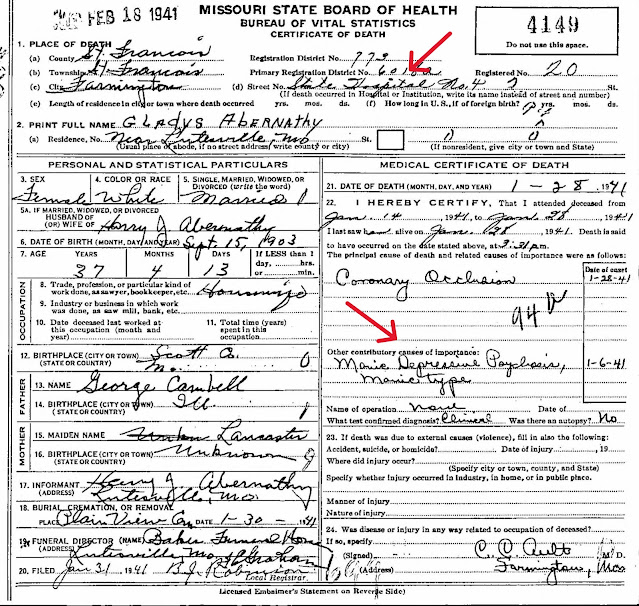On 1 April 1866 in Ladonia, Fannin County, Texas, 18-year-old Nannie Hawkins and 23-year-old Lafayette Abernathy welcomed baby Emma into the world. Nancy A. "Nannie" Hawkins was a daughter of Sarah and William A. Hawkins. Lafayette was one of at least eight children born to Emily and Alphonzo Abernathy (1809-1893).
Emma Abernathy married Exile C. Eagleton (1863-1924), a native of Tennessee, on 1 January 1890 in Fannin County. He was a son of Mary Ethlinda "Ethie" Foute (1836-1917) and Rev. George Ewing Eagleton (1831-1899), both also from Tennessee. Emma and Exile had nine children over eighteen years: Nancy Ethie (1890-1973); Statire Jane (1893-1902); Lafayette Ewing (1892-1918); E. C. (1896-1974); Mary Ross (1897-1975); Marcus D. (1899-1966); Amelia Abernathy (1900-1979); Foute Wilson (1905-1984); and Marvin Dunlap (1909-1969).
 |
| City Hall, Ladonia, Tex. abt 1909. From DeGolyer Library, Southern Methodist University. |
I feel compelled to note - according to the 1910 Fannin County, Texas, U.S. Federal census, Emma had fourteen children. Eight were living at the time. My gut says this is inaccurate, but I don't know for certain.
Emma's auburn-haired son Lafayette Ewing Eagleton was inducted into the U.S. Army at Dallas, Texas on 28 April 1918. He trained at Camp Travis for little more than a month before heading overseas in June. Lafayette was part of the 359th Infantry, 90th Division (Texas-Oklahoma Division known as the "Tough 'Ombres") which participated in the Battle of Saint-Mihiel in northeastern France mid-September 1918.
Though Lafayette survived this battle, he would not survive the next. The Meuse-Argonne Offensive began on 26 September 1918, and this is the date the U.S. Army notes Lafayette was killed in action.
After reading George Wythe's A History of the 90th Division, and given the location of Lafayette's "isolated grave," it seems plausible the young man died during the raid on Preny. From Mr. Wythe's book:
"The plan for the raid contemplated that the raiders would strike due north...while the detachment from the Texas Brigade was to turn east along the valley south of Bois de Beaume Haie and circle Preny...The 37-mm platoon of the 359th Infantry fired 600 rounds on Preny. The barrage was timed to advance at the rate of 100 meters in 2 1/2 minutes. The infantry found it impossible to keep up with this speed. This fact enabled the German machine gunners to crawl out of their concrete pill-boxes after our artillery had passed over and set up their guns to catch the advancing infantry....Machine guns from these positions, as from the woods to the north and west, completely dominated the open space across which the raiders were forced to pass. There were two lines of trenches...each defended by bands of wire. The men were not able to get beyond [the first trench], and only a few reached this position. None who reached it came back to tell the story...Such was our part in the initial phase of the Meuse-Argonne offensive. The mission was to make a demonstration which would lead the enemy to believe that an attack was impending, thus causing him to hold reserves which he could not spare from the real point of attack. The Division succeeded in this mission."
 |
| Cpl Eagleton's Burial Card |
Ten years later, in 1929, the same year the American Gold Star Mothers organization was incorporated, Congress executed legislation that authorized pilgrimages paid for by the U.S. government to European cemeteries "by mothers and widows of members of military...forces of the United States who died in the service at any time between April 5, 1917, and July 1, 1921, and whose remains are now interred in such cemeteries."
A list of all eligible mothers and widows was compiled, and Emma's name can be found on it. The "Yes" in the final column indicates she wanted to make the sponsored trip to visit her son's grave.
 |
| (Click to enlarge.) |
A subsequent Ladonia News article and passenger list for the S.S. President Harding leaving Cherbourg, France on 19 August 1930 suggest Emma, at the age of 64, indeed made the trip.
"Among the gold star mothers who sailed from New York Saturday was Mrs. Emma Eagleton of Commerce, but a lifelong resident of Ladonia until a few years ago. Mrs. Eagleton goes to visit the grave of her son, Lafayette...Eagleton, one of Ladonia's gallant soldiers who made the supreme sacrifice on the battle fields of France. Mrs. Eagleton's friends are happy for her over this pilgrimage and anxiously await her return that they may hear the many items of interest they are sure she will remember to tell."
 |
| Lafayette Ewing Eagleton Corpl. 359 Inf. 90 Div. Texas Sept. 26, 1918 |
The first Gold Star Mother's Day, proclaimed to be on the last Sunday in September, was observed in 1936. Emma Abernathy Eagleton died on 15 January 1939 in Lufkin, Angelina County, Texas. This September 24th, I'll be thinking of you, Emma.
Now on my to-read list:

The Gold Star Mother Pilgrimages of the 1930s*
*As an Amazon Associate I earn from qualified purchases.












